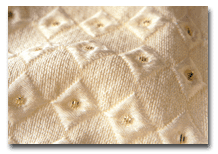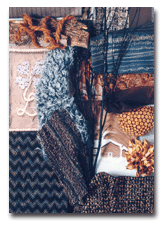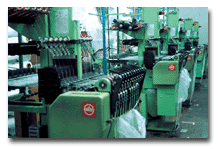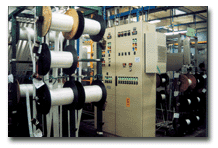Innova®, Polartec® ProvideSevere Weather ProtectionInnova®, a polyolefin yarn manufactured by American Fibers and Yarns Co. (AF and Y), Chapel Hill, N.C., and Polartec® fabric, manufactured by Malden Mills Industries Inc., Lawrence, Mass., are being used in the military’s Extended Cold Weather Clothing System (ECWCS), a five-layer clothing system for use in extreme environments such as those in Afghanistan, Alaska and Bosnia.”Innova yarn is used in the base layer of the ECWCS because of its moisture-management, insulative and quick-drying properties, all essential elements of a protective clothing system’s skin contact layer,” said Mike Apperson, president and CEO, AF and Y.Malden Mills recently secured federal funding to supply Polartec products and research and development services to the US military for use in the ECWCS.The funding wiIl allow the company to develop rugged textile electronic garments for combat wear.Sensors in the garments will monitor respiration, pulse rate, skin temperature and blood pressure. Data will be transmitted via discrete antennae to medics behind the front lines. Development partners include Foster-Miller, Waltham, Mass.; Exponent, Irvine, Calif.; and Eastern Carolina University, Greenville, N.C.December 2002
BASF Develops Dye Liquor PH Regulator
BASF DevelopsDye Liquor PH RegulatorGermany-based BASF AG now offers Eulysin® WP, a pH regulator for dye liquors in baths used to dye wool and polyamide. The auxiliary allows the pH of the dye bath to fall continuously from 8.0 to 5.0 without user intervention, according to BASF. The company also claims Eulysin WP is an eco-efficient product that provides uniform dye uptake, reduced dyeing times and fewer faulty dyeings.December 2002
UGN Opens Manufacturing Facility In Tennessee
UGN Opens Manufacturing Facility In TennesseeChicago-based UGN Inc. has opened a multi-million dollar production facility in Jackson, Tenn. The new facility the companys fourth produces UGNs line of sound-absorbing products used in Toyota vehicles. The company also has plans to transfer production of materials for Honda, Lexus and Nissan vehicles to the new plant by the end of 2002.The 150,000 square-foot building has added 100 new jobs to the Jackson community. Within its third year of operation, the company expects to add an additional 100 jobs.The opening of a fourth facility provides tremendous growth for both our acoustical products and the Jackson community, said Gary Jamison, president and CEO, UGN.UGN was formed in 1986 as a joint venture between Rieter Automotive Systems and Nihon Tokushu Toryo (Nittoku).December 2002
Cone Mills39 Sales Up
Cone Mills’ Sales UpGreensboro, N.C.-based Cone Mills Corp. reported third-quarter 2002 net sales
of $111.7 million, up $4.7 million over year-earlier sales. Third-quarter net income of $3.8
million, or 11 cents per share after preferred dividends, compared with a year-earlier net loss of
$4.6 million, or 22 cents per share.Market conditions for Cones business segments were mixed in
third quarter with denim markets holding up well and home furnishings markets sharply weakened,
said John L. Bakane, president and CEO. Nevertheless, Cone was able to report its best third
quarter earnings in seven years.
December 2002
Creativity Rules At Premiere Vision
By Virginia S. Borland, New York Correspondent Creativity Rules At Premiere VisionParis fabric show goes global, adds satellite shows to offer broadened view of Fall/Winter 2003-04 trends. At this years economic press conference at Premiere Vision, Daniel Faure, chairman, said the global turnover of the 780 weavers who showed last year at Premiere Vision topped 16 billion euros an increase of 3.8 percent over the previous year. He cited innovation and flexibility as factors in being competitive in world markets.Panelists representing various segments of the textile industry noted that 2001 was an atypical year, the bulk of their sales came in the first half. They stressed that business continues to be difficult. However, there are marketing strategies to lift the industry out of the doldrums.Ronald Weisbrod, president of the Swiss firm Weisbrod-Zuerrer AG, and Olivier Fournier, director general of the French firm Bucol, both producers of silk fabrics for haute couture, stressed innovation. We are investing in creativity, said Weisbrod. Fournier said, In our niche market, sales are linked to excellence of design and color.According to Alain Vermeersch, CEO, UCO Textiles, Belgium, the company is encouraging creativity with less emphasis on basics in the denim and sportswear sectors. UCO has acquired a manufacturing facility in the United States that can deliver fashion products quickly. Sales in America are about $60 million annually. Expansion And DiversityInnovation and flexibility are emanating from the exhibition itself. This season, for the first time, Premiere Vision has opened its doors to selected companies from around the world. At the most recent event, there were exhibitors from Japan, Turkey, Uruguay and Eastern Europe.In addition to fabric exhibits, satellite shows were taking place in adjacent areas. Indigo, featuring surface design, and ModAmont, a fashion trimmings and supplies fair, are now part of the total package. This season, Fil Event, which has been organized by Expofil management, showed yarns for weaving and circular knitting. A Season Of NoveltyThere was very little in the way of basic fabrics at Premiere Vision for the Fall/Winter 2003-04 seasons. Intricate designs, new fiber combinations, applications, embellishments and treatments all point to a season of novelty. The lines of demarcation between sectors are blurred, with cotton turning up in the wool sector, cashmere woven and finished to look like denim, silk jersey that has been printed and appliquwith rice paper, antique-finished stretch corduroy and jacquard overlays on traditional Scottish tartans.

A fabric from Mantero-Seta’s Autumn/Winter 2003-04 collection. In the wool sector, Scottish weaver Johnstons of Elgin showed rustic, textured coatings that reverse from tweed to check. The look is harsh and raspy, and the touch is ultra-soft, woven of 100-percent cashmere. There are cashmere/Lycra® blends and cashmere that resembles denim in this line. With the price of cashmere down, double cloths are selling well for unlined jackets.John Gillespie, design director, Johnstons of Elgin, said authentic estate tweeds originally created for the hunt in the mid-19th century are back in fashion. They are colored to blend with the terrain and camouflage the wearer. Woven of 100-percent pure new wool, these tightly constructed fabrics weigh in at 700 grams per meter and provide protection from rain, cold and wind or an occasional tangle with a gorse bush.At Robert Noble, part of the Yorklyde Group, designer Gil Cable said a lot of its traditional tweeds have been Teflon®-coated and backed for use in handbags and luggage. Coach Leather is a name she mentioned. There are honeycombs with high/low surfaces, coatings woven using color-mixed plied yarns, and sophisticated brushed classics dyed in animal hair colors.CalzeatandCo. Ltd., another Scottish weaver, has traditional checks and tartans with jacquard overlays. There are Prince of Wales checks with floral patterns woven using bouclarns, big checks with mini-houndstooth overlays and tartans with twining leaves and flowers. Techno Wools From ItalyItalian wool weavers have diversified. Several have opened new divisions for a broader market reach. At the top, Loro Piana S.p.A., specialists in cashmere and merino wool fabrics, has a techno range for sportswear. There are waterproof, breathable cashmere coatings with a thin membrane adhered to the fabric. One new fabric, a blend of 70-percent merino wool and 30-percent nylon, has the touch of nylon taffeta. It has been selected by Team New Zealand for the 2003 Americas Cup races.At Picchi S.p.A., a new division called Filopuro has fine, stretch worsteds for the suit and casual sportswear markets. Jacquard and novelty brocades are other best-sellers. Double cloths with a rustic look, reversing from flannel to sherpa, also were pointed out.Franco Miliotti of Milior S.p.A. said anything with a luxury look and warm finish is selling. Winter stretch cottons, cotton/wool and cotton/wool/Lycra cavalry twills and ribs with heavenly, brushed surfaces are among the favorites. Special finishes to give a vintage look, delavand transfer prints are other novelties. Corduroy is emerging as another best-seller of the season. Luxury French WoolsFrench wool weavers are into luxury classics that are heavily brushed, reversible and stretch. At De Cathalo S.A., Thomas Brochier, head of the New York office, said cashmere is selling extremely well in the United States, and wool/silk coatings are coming back. There are crinkled surfaces, soft brushed surfaces and shiny aspects in blends of wool/nylon.Carreman is selling stretch denim in a blend of polyester/wool/cotton/Lycra. There are rustic weaves in cotton/wool, easy-care wool blends and a lot of stretch in this line.Isoule Textile has a group of worsted wool/silk blends that look like tussah silk and have a dry silk touch. There are thick, lightweight boiled tweed-look wools woven with twisted yarns; and Chanel-type tweeds in multi-fiber blends.Novelty tweeds are a specialty of AJM France. Irregular, thick, multi-colored yarns have been loosely woven into supple twills and box-weave tweeds. Some fabrics have been brushed and flattened. There are subtle metallic touches, boucl#44; slubs and pigtails.Master of fantasy Malhia is the originator of tweeds for Chanel. For Fall, they are knitted or woven using thick, lightweight, shaggy yarns. There are open patterns with touches of metal, hairy fringes, ropy textures and sequins. Intricate KnitsThe Italian knit company Marioboselli Jersey has two collections of knitted fabrics: Top, which specializes in luxury and natural fibers; and Two, a younger line that is competitively priced. Cashmere is used alone or blended with cotton or silk in the Top line. Some fabrics contain Lycra. There are jacquards, burn-outs, lacy looks, double-faced cloques and hand-painted velours.

Fall/Winter 2003-04 fabric selectionfrom United Kingdom-based mills.Two of the best-selling fabrics at Italian knitter Mabu Jersey contain cotton. One is a ribbed jacket-weight fabric finished to have a warm hand. The other is a double-faced fabric with cotton piqueversing to micro Tactel® flannel. There are wool/cashmere blends, double cloths of wool/silk, micro jacquards knitted using wool/nylon/Lurex, cloques of micromodal/Lycra, and silky/matte fabrics knitted using double mercerized yarns.French knitter Billon Frs is showing sueded knits that are pigment-printed, heat-transfer printed or embossed. One pattern of note is a patchwork of faded mosaics. Another is a mottled leaf design, and a third is a distressed jeans look. At Welbeck Fabrics Ltd., now part of the Farago Group, England, a lot of the fabrics that have been designed for intimate apparel are going into outerwear. Airpak®, a three-layered fabric with a cushion center, and Aphrodite, a knit that simulates the look of bonded fabric, are selling for molded bra cups, robes and sport jackets. Innovations For SportswearTreatments and techniques with denim continue to hold center stage. French technical fabric producer Griffine Enduction is showing polyurethane-coated denim that can support stone washing. Another fabric is double-faced, with fleece reversing to a crinkled leather look.At Nappel, Spain, there are washed denims that have been polyurethane-coated and bonded to fleece. Some look like vintage denim. Other fabrics resemble aged leather. Moleskin/fleece reversibles and heavily brushed twills with a velvet look in cotton/Lycra are best-sellers.Along with denim, corduroy sales are on the rise. Germany-based CordandVelveton GmbH sells stretch and non-stretch corduroy, both greige and finished. Currently the womenswear market is buying baby cord weft stretch. Childrenswear is into ribless and wide wales. Six wale is selling to menswear.The Swiss firm Schoeller Textil AG continues to develop high-tech outerwear fabrics for rugged sports and industrial end-uses. Popular this season are two-layered fabrics that stretch, breathe and are water-resistant. There are ultra-light and strong transparent fabrics in a blend of 75-percent nylon/25-percent elastane.The Spanish firm AGB Textil S.A. has a diverse line of fabrics for casualwear. There is Tencel®/cotton/Lycra corduroy that is cross-dyed and has a washed look. Ultra-lightweight shirting fabrics in cotton/Lycra have a crushed finish. There are Tencel/cotton moleskin, wool blends with four-way stretch, jacquards with a vintage look, and a lot of surface interest through laser cutouts, eyelet patterns and crinkling.At Milag S.A. of France, denim is stone-washed, coated, printed, double-faced, stretch and sanded. Some denim is touched with metallic, puff-printed, or coated to resemble sequins. Printed FabricsFrank Iovino, head of the Miroglio office in New York, said corduroy printed with old-fashioned florals is starting to sell. Velvet and sueded fabrics are of note. Monotones, fractured designs with a blurred or worn look, misted paisleys, veined leaves, Missoni-type stripes, animal skin patterns and romantic florals are among the popular themes.The Spanish firm La Industrial Sedera S.A. has fractured patterns on top of glen checks, mixes of paisleys with animal skins, patchworks and burn-outs. There are double-faced jacquards, cotton stretch and metallics in this line. Best-selling colors are brown, black and eggplant.At the French firm Chaine et Trame, a lot of sales to the United States are going to private label manufacturers and retail design departments. Best-selling base fabrics are nylon, lace, spun rayon crepe with a dry hand, etamine, georgette, sheer knits and pannelvet. Mosaic patterns are of special interest. The Silk SectorFantasy is selling, said Frans Damide, who heads the US divisions of two French companies, Solstiss and Bucol. At Solstiss, a new division called Embeliss has fabrics designed in New York and made abroad. Adornments and embellishments are applied to silk taffeta and burn-out velvet along with lace. There are sequins of all sizes, beads, loops, dangles and crystal drops used together.At Bucol, there are influences from the 1930s, with tarnished gold jacquards and feather fringe stripes in zig-zag patterns. There are disco flowers and twining vines, small leaf designs and warp-printed paisleys.French silk weaver Bianchini Fer showed iridescent mousseline in faded colors, large blurred abstract prints and wavy designs. When the fabrics move, the colors change.There is a lot of novelty and fantasy in Weisbrod-Zuerrers Fall line. Each fabric is woven and embellished with a lot of different techniques. There are pleated stretch jacquards; puckered tweeds with fleece stripes; Lurex in tartan patterns applied over paisley and flower designs; plissthat are pressed with metallic; laser cutouts on double-woven crushed taffeta; patchwork tweeds embroidered with buttons, sequins or raffia; and a lot more.Donatella Ratti of the family-owned Italian silk weaver Ratti pointed out three directions that are especially popular. One is soft and inspired by nature, with traditional flowers printed on cotton velvet and silk satin. Another has an ethnic theme with large, stylized floral designs. The third is called Modern Kimono, with optic and graphic patterns combined with chrysanthemums. The look of denim has been printed and sometimes overprinted with flowers. Another Italian silk producer, Mantero Seta S.p.A., is showing one line developed for haute couture and another that is more competitively priced. The Stile line has jacquards and tweeds with a vintage look. They are woven with silk and wool.First-time exhibitor Kimura Senko Co. Ltd. of Japan showed a diverse line. Printed silk jersey is appliquwith rice paper. Scratched denim with a frayed look is glued to nylon stretch tulle. One fabric, called Shooted Denim, looks as if it has been randomly hit with buckshot. Boiled, felted wool with pressed-in patterns is bulky and extremely lightweight. The next Premiere Vision will be held in Paris, February 12-15, 2003. European Preview will take place in New York City, January 23-24, 2003.December 2002
Tajima Machines Receive Safety Approval
Tajima Machines Receive Safety ApprovalFranklin Lakes, N.J.-based Tajima America Corp.’s TFHX series of 2-, 4-, 6- and 8-head bridge-type embroidery machines, assembled by Tajima U.S.A., has earned ETL approval from Underwriters Laboratories Inc., Northbrook, Ill. The embroidery machines, which meet the standards of UL 1;~94 and CSA 68, now are able to bear ETL markings.According to Tajima, the TFHX series is the only ETL-approved embroidery machine on the market. The company plans eventually to have all of its machines ETL-approved. December 2002
Comex A Century Of Leadership In Narrow Fabrics
Textiles In Mexico
TW Special Report Comex: A Century Of Leadership In Narrow Fabrics
State-of-the-art technology, research and development, and high quality standards help to
further this Mexican company’s long-term success. Founded in 1897, Compania Mexicana
Textil, better known in the marketplace as Comex, is a famiIy-owned Mexican company that works
under very high standards of efficiency and quality.The company, whose slogan is “A Tradition of
Quality,” has a long historv of manufacturing all kinds of narrow fabrics including ribbon,
elastic, webbing, trimming, bias tape, cord, hook and loop, and much more.The Comex narrow fabrics
operation is considered a top example in the textile industry, using the most up-to-date technology
in all its processes, preparation, weaving, dyeing and packaging. Company StrategiesComex’s
long-term success has been based on the following strategies: People are the main strength of the
companya highly skilled wofkforce driven by continuous improvement without compromising standards.
Customers are the focus of all operations, with a very close relationship based on respect,
honesty, feedback and superior service. State-of-the-art technology in all manufacturing processes
offers a competitive edge. Research and development is a must. All work must meet the company’s
high quality standards. Manufacturing PlantsComex has three manufacturing plants with about
700 looms, continuous dye ranges and computerized packaging machineryeach for a specific type of
product. Each plant operates three shifts, six days a week, with an average of 91 percent working
efficiency at very high speeds. Plant No. 1 manufactures all kinds of ribbon from 1.5
millimeters (mm) up to 130 mm; in solid, multicolor, multiweft and jacquard; for apparel, crafts,
home decor and industrial markets. Materials used include polyester, polyamide, and metallic yarns.
Bias tapes are made using cotton or polyester.

Comex’s ribbon plant is equipped with Jakob Muller weaving machines. Plant No. 2
manufactures custom-dyed, plain and jacquard woven and knitted elastic for intimate apparel. Widths
range from 3 mm up to 100 mm. Materials include polyamide, polyester, spandex and rubber. The plant
also manufactures trimming, fringe, cord, gimp and net for apparel, home decor, furniture and
craftsall made using rayon, polyester, cotton and Lurex® yarns.Plant No. 3 is Comex’s subsidiary
“Cintas y Telas Elasticas,” better known in the market as “Cytesa.” It manufactures woven heavy and
light webbings for seatbelts, harnesses, slings, safety equipment, travel gear, Iuggage, shoes,
containers, military items, hats, and curtain tapes; from 12 mm up to 200 mm; in solid, multicolor
and jacquard; using polyester, polyamide, Kevlar®, Nomex®, fiberglass, cotton and polypropylene
fibers.Cytesa also produces woven reinforced elastics for orthopedics, sportswear, shoes and
apparel; from 10 mm up to 250 mm in width; in solid, multicolor and jacquard; using polyester,
polyamide and cotton with rubber or spandex. Equipment InstalledVertically integrated, Comex
does its own twisting and yarn dyeing. Each plant has a laboratory with the most modern
spectrophotometers, elongation and modulus equipment, crockmeters, launderometers, and
weatherometers for checking colorfastness, as well as other equipment for testing flammability and
tenacity.With the main objective of giving its more than 4,000 global customers consistent quality
in its products and services, Comex certified its quality management system in June 2002 in
accordance with ISO 9001:2000 standards under the supervision of Bureau Veritas Quality
International.

Equipment for product finishing assures consistent high quality.The Comex managing team knows
that after 105 years of existence, it has inherited a big responsibility, and it accepts the
challenge to maintain its leadership.
December 2002
INTIMA America Intimate Apparel Salons To Merge
Intima America, Intimate ApparelSalons To MergeAtlanta-based Messe Frankfurt Inc., producer of INTIMA America, has acquired the Intimate Apparel Salons, organized since 1990 by Exposition Associates LLC, Brookfield, Conn. Messe Frankfurt and Exposition Associates will co-produce three annual trade shows currently produced by Exposition Associates in New York City.The March 2003 Intimate Apparel Salon will maintain its current format and location. An expanded August 2003 edition will be co-branded with the INTIMA Arnerica and Intimate Apparel Salon logos, and will expand and relocate to the North Pavilion of the Jacob Javits Convention Center in New York City. The newly designed show will feature on-the-floor fashion shows, special events and an expanded swimwear section.December 2002
New Canon LDV Sensors Aid Production Control
New Canon LDV SensorsAid Production ControlCanon U.S.A. Inc. Semiconductor Division, Encoder Products, Lake Success, N.Y., reports its two new LDV sensors P-50Z and P-20Z provide precision control of product runs, and help reduce costs and waste in textile manufacturing. The compact sensors have a dual convergent semiconductor laser that can measure all types of fabrics during manufacturing, sizing and cutting. They provide accurate measurement of the velocity of running textiles without directly contacting the fabrics.The sensors can be used with both high- and low-density fabrics with reflectivity factors as low as 20 percent. The P-50Z is designed for use with large runs or faster run rates. The P-20Z is appropriate for measuring delicate or sensitive fabrics manufactured at slower speeds.December 2002
KoSa To Invest In Shelby Plant
KoSa To Invest In Shelby PlantKoSa, Charlotte, will invest in renewal of its Shelby, N.C.,
facility, which produces polyester technical filament used primarily for sewing thread, as well as
polyester textile filament.The company will update manufacturing technology, expand low-denier
polyester technical filament capacity, upgrade the spinning process and install state-of-the-art
draw-twist equipment. Production of polyester textile filament will continue.KoSa expects to
complete the first phase of the renewal, adding 8 million pounds of capacity, during the fourth
quarter 2003.This investment will strengthen KoSas position as a leading global supplier of
low-denier polyester filament for sewing thread applications. This project firmly demonstrates
KoSas continuing commitment to NAFTA and the global marketplace for polyester sewing thread
filament products and services, said Thomas Kehl, vice president and general manager, Technical
Fibers.
December 2002




